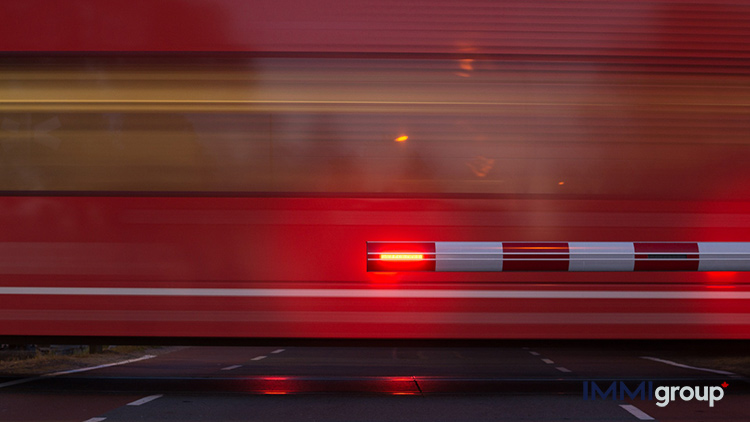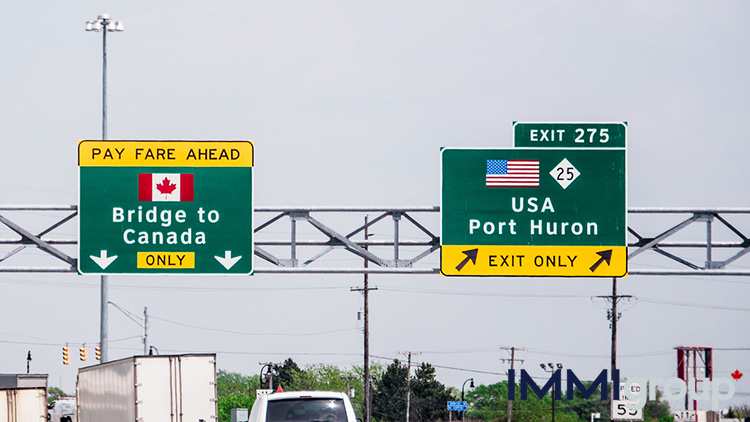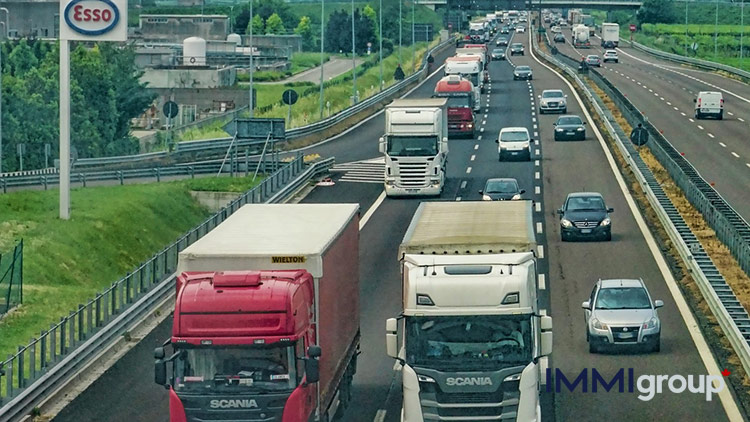Flagpoling Your Way to a New Work or Study Permit, or Permanent Residence

Flagpoling means applying for the renewal of your work (or study) permit by leaving Canada at a border crossing with the USA, and re-entering immediately. The same practice is also used for those seeking to validate their PR status and/or PR visa. In other words, you take a trip “around the flagpole” and re-enter Canada where you present your documentation and get that new work or study permit stamp in your passport.
Why do people do this odd little hack? Because it saves a lot of time.
Updated to reflect restrictions at the Niagara border crossings.
How to Flagpole at the US Border and Secure Your Status – Updated
What the heck is Flagpoling?
Flagpoling means applying for the renewal of your work (or study) permit by leaving Canada at a border crossing with the USA, and re-entering, sometimes immediately. The same practice is also used for those seeking to validate their PR status and/or PR visa. In other words, you take a trip “around the flagpole” and re-enter Canada where you present your documentation and get that new work or study permit stamp in your passport. Immigroup strongly recommends staying in the US for some time before re-entering Canada.
Why do people do this odd little hack? Because it saves a lot of time:
If you apply for a renewal of your work or study permit by mailing your application to IRCC-Vegreville, it will take up to or even more than 16 weeks for you to get your renewed permit approved, depending upon your situation. (Paper applications take much more time than online applications. If you can, always renew online.)
If you are a temporary resident of Canada and you need to validate your
- Confirmation of Permanent Residence or,
- Permanent Resident Visa.
You can also apply to your nearest IRCC office by calling IRCC’s Call Centre at 1-888-242-2100 in order to book an appointment. Please note that you must call this number from inside Canada.
Or, you can leave Canada and return through an international airport in Canada, or by the land border. Clearly, leaving and returning by a land border with the USA is a much faster and cheaper option. Here’s how it works:
- By flagpoling, you reduce that wait for an appointment with an immigration officer.
- Or, for your work or study visa application to be renewed, you reduce the wait time from a few months, to a matter of minutes at the Canadian customs building at the border. If you are not sure if you can flagpole for your particular work or study permit extension/renewal, please read the comments of this article where many helpful people have shared their flagpoling experiences.
- Or in the case of temporary residents wishing to validate their new PR status, flagpoling offers a quick and cheap alternative to waiting weeks or even months for an appointment at your local IRCC office.
Of course, your total time with the trip to the border, often in your car or a rented car is a matter of hours in total. Maybe even the better part of a day. That’s still a lot less than waiting weeks for your new permit, or an appointment to validate your PR status at a IRCC office.
Seems too good to be true, right?
There are some views that suggest that the Canadian Border Services Agency (CBSA) does not like the practice of flagpoling as it turns border agents into full-time immigration case officers processing individuals already in Canada who – strictly speaking – should have their cases done by the people at IRCC’s case processing centres. There apparently have been meetings and conversations within both CBSA and IRCC about how to discourage flagpoling, and theoretically, you could be caught in a no-man’s-land at the border if Canada refuses you re-entry.
More importantly: if you immediately flagpole, without spending time in the US, you will have to report this instance of flagpoling every time you travel to the US for the rest of your life.
Who Can Flagpole?
The key to the whole practice of flagpoling is the way visits to the USA as well as St. Pierre and Miquelon are treated under the Immigration and Refugee Protection Regulations (IRPR); specifically regulation 198 and regulation 190.
Regulation 198: This, in part, states that:
- Residents of the USA, or St. Pierre, & Miquelon, may re-enter Canada after a visit to these three places without requiring a temporary resident visa or TRV. And they can apply for a work or study permit at the Point of Entry (POE) – in other words, the border crossing where they re-enter Canada. However, this exemption is also available to:
- Residents of TRV-exempt countries whose jobs are LMIA-exempt;
- Residents of TRV-exempt countries who have a positive LMIA.
- In other words, if you are a foreign national from a country for which Canada does not require a Temporary Resident Visa, then you can apply for a work permit while re-entering Canada after a visit to the USA or St. Pierre & Miquelon.
- You can also have your PR status and/or PR visa validated if you are a temporary resident who has just been notified of your new PR status and how wants to avoid the wait for an appointment at a local IRCC office.
Regulation 190: This states that a foreign national (in other words, someone from a non visa-exempt country) is exempt from the requirement to obtain a temporary resident visa if they are seeking to enter and remain in Canada:
- After a visit to the USA, or St. Pierre & Miquelon AND IF THEY
- Hold a study or work permit issued to them before they left Canada on such a visit, or were authorized to enter and remain in Canada as a temporary resident or to validate their new PR Status and/or visa, AND
- Return to Canada before the end of the period initially authorized for their stay or any extension of it.
Please note that you are not allowed to flagpole if you are a Seasonal Agricultural Worker.
What actually happens at the border?
- Once you cross into the USA – especially if you cross on foot and usually at the Surrey BC crossing or Southern Ontario border crossings – you may be directly asked if you are flagpoling by the US immigration authorities.
- If you have not planned a trip to the US, you will be given a slip of paper that indicates you have been refused entry to the USA. Plan a trip to the US in order to flagpole to avoid being refused entry to the US.
- When you return to Canada, you will be directed to the Canadian Customs building.
- Note: Another drawback of flagpoling immediately is that the CBP officer may express their displeasure with you doing flagpoling. This is not personal; CBP officers are just expressing their frustration with the process.
- At the Canadian Customs building, you will approach the border/customs agent, say you are applying for a new Work or Study Permit, and present your documentation, including your refusal-of-entry slip from the US authorities:
- Valid passport,
- Current Work or Study Permit,
- Job contract signed by both you and your employer in Canada,
- Positive Labour Market Impact Assessment if required,
- PNP Nomination Certificate if required,
- PNP Work Permit Support Letter if required
- CAD$150 for fee payment,
- A Work Permit application form is not required but it is a good idea to bring a completed one along in case the CBSA officer requests it.
- Valid Medical Examination Certificate from a Canadian DMP (panel physician) if:
- If you work in a public-health sensitive occupation like Health Services, Child Care or Education,
- If you have lived for 6 months or more in a “designated” country.
- If you are getting your PR status/visa validated, you will need the following documents:
- Valid passport, OR
- Travel or identity document with visa sticker if you have one
- Confirmation of Permanent Residence, OR
- Permanent Resident Visa, OR
- Letter of Introduction along with any instructions from the Canadian Visa Office
- Proof of Legal Status in Canada including one of the following:
- Work permit
- Study permit
- Temporary Resident permit
- Visitor Document
- Any immigration document you have whether valid or not
- Proof of Implied Status: if you had to renew your stay. This could include:
- Payment receipt
- Copy of application to extend stay
- Printout of online application
- Proof of Mailing
What Could Go Wrong?
Also read: HOW TO TELL AN IMMIGRATION OFFICER THEY’RE WRONG
Occasionally there have been reported cases of people being refused entry back into Canada. Remember, the US immigration authorities have also refused you entry if you did not have a US visa or you just came to flagpole, so you may be caught in a no-man’s-land.
If you flagpole immediately, and do not travel within the US, you will have problems in the future. For example, you will have to declare every time you re-enter the U.S., at all later dates, that you have been refused entry previously to the USA. It will be in their databases once you flagpole. We strongly suggest going out for dinner or going shopping. It is best to stay over night if you can. (This is all provided that you are allowed to enter the United States, of course.)
As well, you may, under some circumstances, be denied entry back into Canada. If that should happen, you will have been refused entry into BOTH the USA and Canada. While some evidence (copies of internal emails) suggest that the CBSA would like the IRCC to discourage flagpoling or even ban it; that has not happened yet and may never happen. And these refusals of re-entry into Canada almost certainly have to do with a person’s admissibility into Canada, and not the practice of flagpoling itself.
In other words, if there are any questions on the part of Canadian immigration authorities regarding your status as a temporary worker or student in Canada, you will be placed in a very vulnerable position should they refuse you entry back into Canada. Needless to say, you must ensure you have all the correct documentation and ensure your status is well supported by the documentation you bring with you. Before you flagpole.
Finally, be sure that you flagpole at the right border crossing at the right time:
Flagpoling Restrictions at the Niagara Border
Please Note: As has been reported in the comments on this article below, since spring 2017, CBSA has been refusing to allow flagpoling at the Niagara border crossings during peak hours. To our knowledge no official information has been released to the public, but PriceWaterhouseCoopers claims they have confirmation from the CBSA that these restrictions are in effect going forward: You may not flagpole during peak periods, i.e. Friday to Monday, at the following Niagara border crossings:
- Fort Erie/Buffalo (Peace Bridge)
- Niagara Falls (Rainbow Bridge)
- Queenston/Lewiston
Non-peak appears to be Tuesday to Thursday. To find another border crossing which is not affected by this policy change, please see here. Speculation is that the CBSA does not like the practice and is trying out this procedure on the Niagara border to see if it will encourage IRCC to make policy changes which would reduce or end flagpoling, but we cannot confirm this at this time.
In the end, flagpoling is NOT illegal and can be a convenient option for those wishing to renew a temporary work or study permit, as well as those wishing to validate their PR status or PR visa. As long as you meet all the other requirements for admissibility into Canada, including Medical Exams and LMIAs, you should be fine to re-enter Canada. Immigroup strongly recommends travelling to the US for at least a day as part of your flagpoling trip in order to avoid being denied entry.


